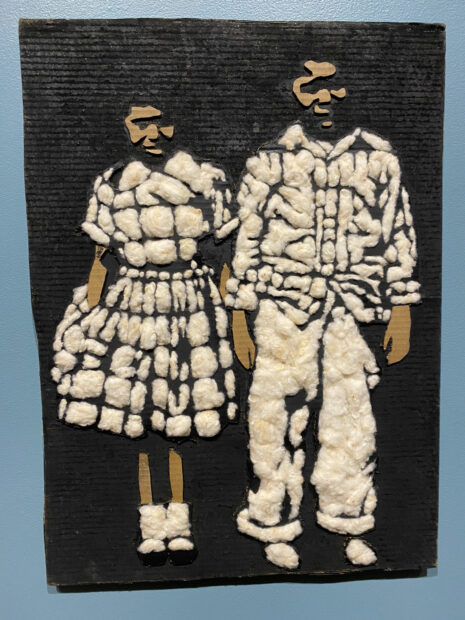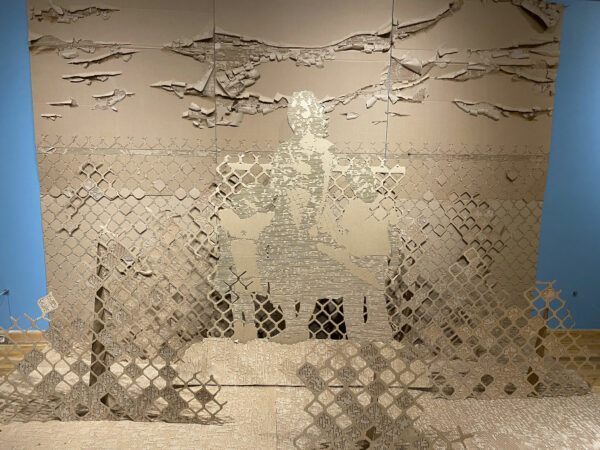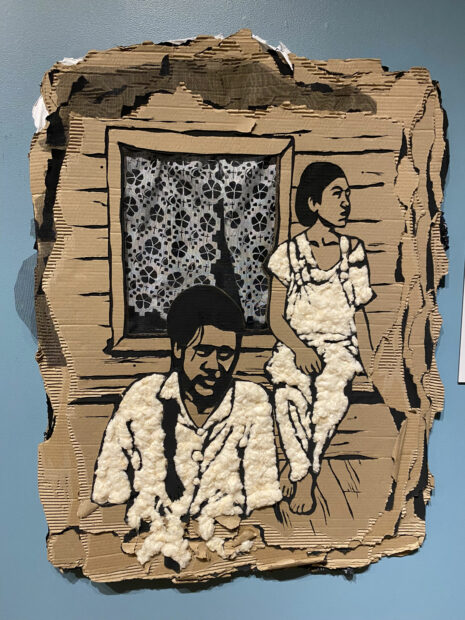
A work from Gina Gwen Palacios’ exhibition “Vale la Pena/It’s Worth It,” on view at the Branigan Cultural Center in Las Cruces, New Mexico. Photo: Hannah Dean.
In the heart of Las Cruces, New Mexico’s vibrant downtown sits the Branigan Cultural Center, a charming adobe museum with a bright red door. Recently, my daughter and I made a day trip to the institution to see Gina Gwen Palacios’s Vale La Pena/It’s Worth It, an exhibition of multimedia cardboard and painted portraits of the artist’s own family and their experience as migrant workers along the south Texas/Mexico border.
Palacios presents a specific personal history, like the reference to her hometown of Taft, Texas. A cardboard sign boasting the slogan “Friendliest Cotton Pickin’ Town in Texas” sits above three figures — Palacios’s grandmother, father, and tia (aunt). The artist left their faces blank, but stained the color of the cardboard using oil, leaving the portrait ambiguous. Many of the large cardboard works leave the figures “open” in this way by abstracting, obscuring, or completely omitting the individual features of the people portrayed, blending the person into the background of the piece. This mother and her children represent generations who lived and worked as migrant farm laborers — treated as outsiders in a place they may have inhabited for centuries.
There is a desolation in the aesthetics of the show, with humble shapes of cardboard casting shadows and silhouettes. The color palette is by no means dull — the patterns and cuts that create each slice of an ear holding back hair, a linoleum floor, the pattern of a dress, or the clasp of an overall are masterful and overwhelmingly delicate. By merging the individual into their settings, there is a nod to liminal space and borders, but even more a strong acknowledgment of a laborer’s body being swallowed up by the sun, the earth, or rather, land, which implies ownership.

A work from Gina Gwen Palacios’ exhibition “Vale la Pena/It’s Worth It,” on view at the Branigan Cultural Center in Las Cruces, New Mexico. Photo: Hannah Dean.
Borders shift and change — what is now Taft, Texas was formerly the ranch of the half-brother of President Taft. Before that, it was a settlement of Mexican-government granted land for Irish settlers. Before that, the Lipan Apache (a group with a massive territory that also assimilated other groups) had settled what is now New Mexico and Texas since the 1300s. Borders designate ownership and place, but they also have rote, practical functions — something that was easy to forget when the “build the wall” slogan has become a mantra for xenophobia.
Words are a core feature of this new tribalism. For instance, in researching Taft, the website for the Texas State Historical Association describes the Mexican army as an “ever present menace” in the newly developed San Patricio county. Palacios neatly points to these tensions of a new United States in her work — especially in Cotton-Pickin’, where her grandmother poses with her children in front of the Taft town welcome sign — and it’s easy to assume this is a gesture of belonging to this community. The sign itself has a defunct “S” in the word “Friendliest,” which is carved sliding down the sign itself, a nod to the attention to detail Palacios imbues in her work. Colloquially, the phrase “cotton pickin’” has overtly racist origins, and is typically used as a euphemism for the word “damn,” or is often used with derogatory intent. This restrained and minimal artwork is layered and loaded with meaning, with Palacios’s adept hand twisting the gears of critical thought.

A work from Gina Gwen Palacios’ exhibition “Vale la Pena/It’s Worth It,” on view at the Branigan Cultural Center in Las Cruces, New Mexico. Photo: Hannah Dean.
In the pieces that depict home life, both titled Esperando/Esperanza I and II (Waiting/Hoping), young girls gaze off to the side, heavy with expectation. The same tyvek curtain appears in both pieces — in the first it is tied back to expose an equally black view outside as inside the room, in which Palacios’s grandmother sits on a suitcase. A small crucifix and patterned floor are the only visual cues to the interior of the home. The young lady’s Mary Jane shoes and ankle socks lend a feeling of youth, along with her leg casually weighted and bent at the ankle. Just like in Esperando/Esperanza II, the natural repose and body language of the seated figures gives these pieces an air of timeliness, being of the now, rather than distant history.

A work from Gina Gwen Palacios’ exhibition “Vale la Pena/It’s Worth It,” on view at the Branigan Cultural Center in Las Cruces, New Mexico. Photo: Hannah Dean.
Material use in the show speaks volumes. The hand-carved cardboard, cotton, and charcoal bear meaning and mood. In Hermana y Hermano (Sister and Brother), the posterized cuts that depict the faces of Palacios’s father and tia imply intense sunlight bearing down on the children as they pose for a photo in their cotton clothing (to which the artist gave immense attention in comparison to the person they adorn). While made of small fluffy clouds against the black surface of the work, the clothing holds weight. The overarching theme of exploitation of migrant workers is constant throughout the exhibition — and the clothing that overwhelms each child’s figure easily speaks to the continued exploitation of people through the fast fashion industry. While Palacios’s work is specific to the southern U.S./MX border, the themes she addresses also touch a nerve globally.

A work from Gina Gwen Palacios’ exhibition “Vale la Pena/It’s Worth It,” on view at the Branigan Cultural Center in Las Cruces, New Mexico. Photo: Hannah Dean.
The inclusion of oil paintings on canvas enhances the feeling of intense sunlight cascading down upon the exposed hands and faces of farm laborers. This harsh light comes through in one small painting, Mezquite, with hot pink and orange light playing upon the twisting branches of a mesquite thicket. This painting puts forth notions of shade, respite, or peace in contrast to heat, sweat, or a tangle of thorns. Palacios, through her own family history and archives, shows us the space between othering and belonging, narrative and place, importance and dismissal — themes that permeate the cultural heritage and future of our borderlands and our country.
Vale La Pena/It’s Worth It is on view at the Branigan Cultural Center at the Las Cruces Art Museum through March 25, 2023


